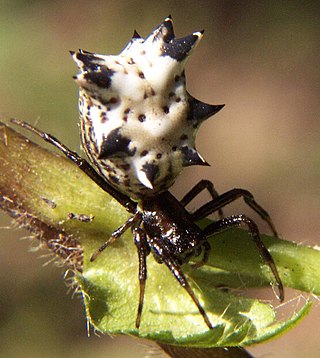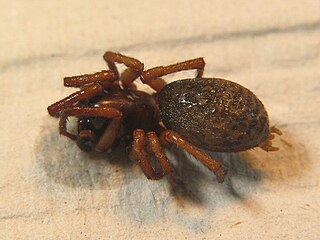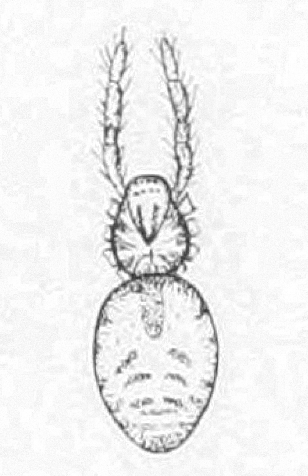
The family Dipluridae, known as curtain-web spiders are a group of spiders in the infraorder Mygalomorphae, that have two pairs of booklungs, and chelicerae (fangs) that move up and down in a stabbing motion. A number of genera, including that of the Sydney funnel-web spider (Atrax), used to be classified in this family but have now been moved to Atracidae.

Micrathena gracilis is a spider in the family Araneidae (orb-weavers), commonly known as the spined micrathena or castleback orbweaver. This spider spins a moderately large and very tightly coiled web. The spiders themselves are small and can be found to be anywhere from 4.2 mm to 10.8 mm long. Its venom is harmless to humans. M. gracilis is unique in appearance due to its large spiky abdomen and black and white bodies. Certain spiders of this species can also display a yellow color on the sides of their bodies. These spiders can be seen most active during the end of the summer and beginning of fall. M. gracilis is diurnal and are rarely ever seen active at night.

Actinopodidae is a family of mygalomorph spiders found in mainland Australia and South America usually in open forest. Species are most common in Queensland, Australia. It includes mouse spiders, whose bites, though rare, are considered medically significant and potentially dangerous.

Sason robustum is a species of barychelid trapdoor spiders. It is only found in southern India, Sri Lanka and the Seychelles.

Gasteracantha cancriformis is a species of orb-weaver spider. It is widely distributed in the New World.
Bristowia heterospinosa is a species of jumping spider from Asia. It was first found on Krakatau, but later also in Vietnam, Malaysia, Singapore, China, Korea and Japan.

Inermocoelotes is a genus of funnel weavers first described by S. V. Ovtchinnikov in 1999.
Inermocoelotes drenskii is a funnel-web spider species found in Bulgaria.
Inermocoelotes gasperinii is a funnel-web spider species found in Croatia.
Inermocoelotes halanensis is a funnel-web spider species found in Croatia.
Inermocoelotes karlinskii is a funnel-web spider species found in Southeastern Europe.
Inermocoelotes microlepidus is a funnel-web spider species found in Italy, Bulgaria and Macedonia.
Inermocoelotes paramicrolepidus is a funnel-web spider species found in Greece.
Selenogyrus caeruleus is a species of tarantula native to Sierra Leone.

Macracantha is a genus of Asian orb-weaver spiders recognized as containing the species, Macracantha arcuata., although some schemes also recognise inclusion of Gasteracantha hasselti in this genus. Macracantha is notable for the extremely long, curved spines on the abdomens of female members of the genus; Eugène Simon created the taxon name from the Greek words μακρός and ἄκανθα (spine). It occurs from India and China through Southeast Asia to Indonesia.
Microbianor globosus is a species of jumping spider in the genus Microbianor that lives in South Africa. It lives on the banks of the Orange River in Northern Cape. The species was first described in 2011 by Charles Haddad and Wanda Wesołowska. It is a very small spider, with a carapace typically 1.1 mm (0.043 in) long and an abdomen typically 1.2 millimetres (0.047 in) long. The carapace is high, broad, short and almost completely dark brown. The abdomen is oval with a white pattern of patches around a central line. The front pair of legs are longer and brown, the remainder being yellow. The male has a characteristic long embolus that curves around the palpal bulb. There is an unusually large spike or apophysis on the pedipalp tibia. This helps identify the species. The female has not been described.

Afraflacilla refulgens is a species of jumping spider in the genus Afraflacilla that lives in Zimbabwe. It lives in loose conglomerations in nests of white papery silk and is particularly visible in September and October. The males will display to each other, but will retreat if they feel threatened. A small spider, it has a dark carapace that is between 1.7 and 2.2 mm long and an abdomen between 1.9 and 3.0 mm long. It has a very dark, nearly black, eye field, although the male has a very thin white line behind the first row of eyes. The legs are generally yellow, apart from the front pair on the male, which are brown, longer and stouter and used for stridulation. The male abdomen is black with a pattern of white spots. The female abdomen is very dark brown, nearly black at the front and yellow to the rear. Both have a distinctive iridescent patch at the back of the abdomen that is recalled in the name of the species, which is a Latin word that can be translated "brilliant". It is this iridescent patch that helps to distinguish the species, although a study of the copulatory organs is needed to confirm its identity. The spider was first described in 2008 by Wanda Wesołowska and Meg Cumming. Originally allocated to the genus Pseudicius, it was moved to its current name by Jerzy Prószyński in 2016.

Dorymetaecus is a monotypic genus of Australian araneomorph spiders in the family Phrurolithidae, containing the single species, Dorymetaecus spinnipes. It was first described by William Joseph Rainbow in 1920, and has only been found on Lord Howe Island. Rainbow died in November 1919, shortly before publication of the work this species is described in.
Pochyta lucida is a species of jumping spider in the genus Pochyta that lives in Gabon. A small spider, it was first described in 2021 by Wanda Wesołowska and Tamás Szűts. It has an oval cephalothorax that is 2.3 mm long and an ovoid abdomen that is 2.8 mm long. It is generally light, with a yellow carapace and greyish-beige abdomen, which is recalled in the species name, which can be translated "light". The spider's eye field is orange and there are dark rings around the eyes themselves. It has yellow legs, the front pair having extremely long spines as is typical for the genus. The female has distinctive copulatory organs, with a noticeable ridge in the middle of its epigyne and short insemination ducts. The male has not been described.

Pseudicius africanus is a species of jumping spider in the genus Pseudicius that lives in Lesotho and South Africa. The spider was first defined in 1903 by George and Elizabeth Peckham. It is small, with an oval cephalothorax measuring between 2 and 2.5 mm in length and an ovoid abdomen that is between 2.2 and 2.5 mm in length. The female is smaller than the male. Otherwise, they are similar, generally dark brown but with white stripes, made of hairs, down the middle and the along the sides of the top of both the carapace and abdomen. The underside of the abdomen differs in being grey and marked by two lighter lines. The female's legs are also lighter, and the front legs on the male are stouter than all the others. The pattern on the abdomen helps distinguish the spider from the related Pseudicius maculatus. It also has distinctive copulatory organs. The male has a shorter curved embolus and a characteristic tooth near the base of the tibial apophysis, or spike on the palpal tibia. The female has copulatory openings are on the edges of its epigyne.









